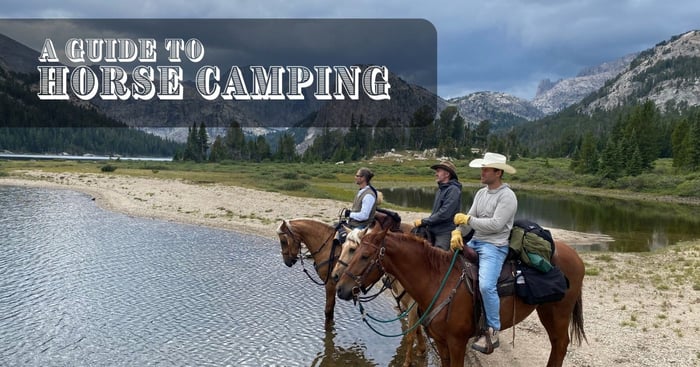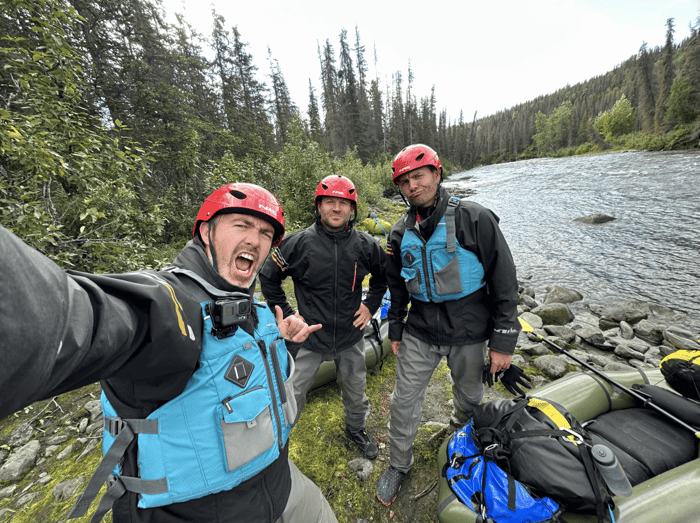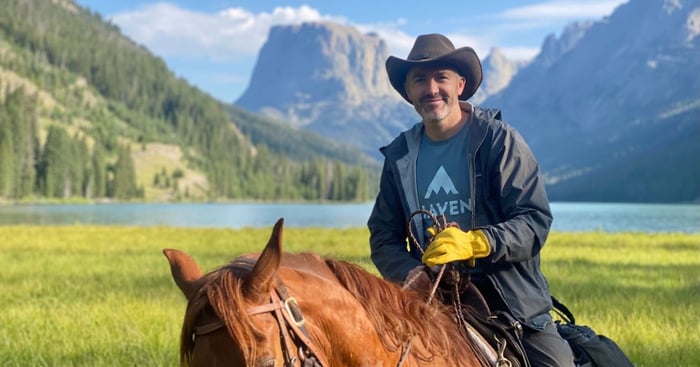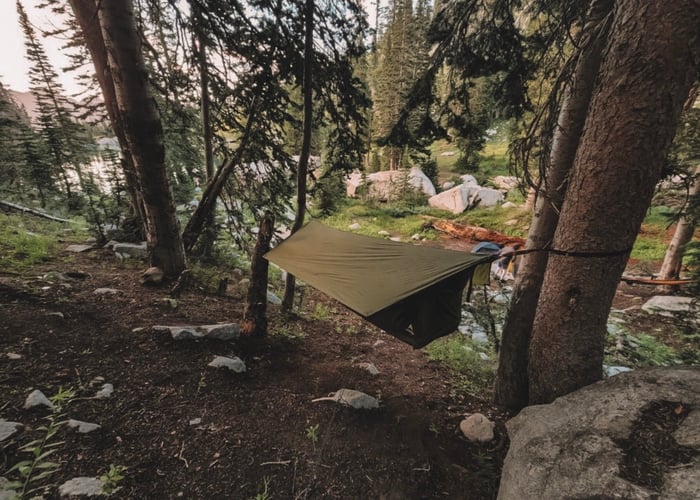Horse camping? Horse packing? Backpacking with horses? We are not sure what to call it, but one of our favorite ways to adventure is on horseback. If you're more of a watcher than a reader, dive into the adventure below. But if you came for details, read on!
When we meet other horse campers in the backcountry, it’s always the same slow-moving train of riders leading pack animals. Mules or horses, the train is slow and overloaded. Like a trapper heading into the wilderness for a year or two, not a couple of guys out for a weekend.
A few years back my cousins and I were planning a week-long trip through Yellowstone. For this extended trip, we planned to bring an extra horse and tracked down some panniers - big saddlebags for a riderless horse. The problem was… we ride gaited horses.
We generally ride Missouri Fox Trotters which are known for their fast-smooth gait. While trotting, the rider gives the horse cues to keep it gaiting along. You cover a lot of ground and it is a very comfortable ride.
We envisioned ourselves sailing through the Yellowstone countryside while our riderless packhorse bounced and banged its way along after us. Breaking and scattering gear along the trail. With our style of riding, packing an animal was a non-starter!
Instead, we decided to merge the worlds of horseback riding and backpacking into one efficient means of travel. This approach has enabled us to saddle quicker, move at our speed, manage fewer horses, and have a smaller impact on the country.
Over the past few years, we have streamlined and improved our system with these tried and tested hacks.
Saddle Bags
We’ve seen some riders wear an actual backpack while riding their horse. We see a lot of cons to this… it is hard to mount and dismount and makes the weight of a pack awkward for both horse and rider.
Saddlebags are the obvious solution. The weight stays securely in place and low on the horse’s back. For the last three years, we have been using bags made by Horse Trail Barn.

Our saddle bags are modular. Each compartment attaches to a pad with velcro and buckles. Along with weight, breaking the bag up into separate pieces has a lot of advantages.
I generally make one side bag my food and food supply bag. This way it can be hoisted into a tree at night as a bear bag. While the other side bag has my clothing and camp items I want handy. I put this above the spreader bar in my tent and attach the handle to the ridgeline. The top bag generally holds my sleep system and sleeping bag. This is also secured with velcro and buckles.
NoShift Saddlebag Stays
Sometimes the smallest things make the biggest difference. Along with great bags, Horse Trail Barn also sells a simple accessory that instantly locks saddlebags in place. When we first started horse camping, we’d spend the first 10 minutes of our ride strapping everything down with paracord. Inevitably, packs would shift and stuff would have to be repositioned and retied
Saddlebag Stays are little metal pieces that screw into your saddle creating a secure connection point for your saddlebag. Quick on and quick off. In all of our trips using these stays, we’ve never lost a bag or had anything slide to a side.
Even when my saddle was loose and the whole saddle flipped over, these two metal hooks held everything right in place!!

Highline and Hobbles
Once your mount is sorted, we just try to make each piece of tack and horse gear as light as possible.
Whether you’re stopping to fish or tucking in for the night, you need to secure your horses. For this, we use a combination of hobbles and highlines.
Hobbles are a set of cuffs with a line or chain between them. Secured to the front feet. They are great for a quick stop or to give your horse time to graze. Hobbles restrict horse movement, but after a while, a horse can become very adept at moving in hobbles.

I remember watching our four hobbled horses galloping away along the Yellowstone River. We found them about half a mile from camp. A few hours of inattention and your horse can go a good distance... typically back toward the trailer. We’ve started making our own hobbles with soft nylon rope. You can learn more about that here.
At night we generally use a highline. This is a line of rope strung between two trees. Horses are tied to the line away from each other or any obstacles. They should be able to reach their head to the ground (to eat) but shouldn’t have so much slack that they will step over the lead.

We use 2-inch tree straps to protect the trees and use a trucker’s hitch to get the line tight. In our ongoing quest to reduce weight, we have transitioned from nylon ropes to Dyneema. Dyneema is much lighter and quite a bit stronger as well. 50’ of 1/8” Dyneema is a great place to start.
Using a highline has the added benefit of giving your horse more freedom to move and eat which prevents the horse from getting restless and bored. A frustrated horse will paw at the earth which erodes campsites and will keep you up most of the night. A prusik knot lets your horse slide up and down the line, but make sure he doesn't get tangled up on trees or other horses.
Once we had something (not sure what) spook the horses. We had three of our four horses tied to one highline. When they pulled, the Dyneema snapped and the three went running off. Luckily we had one still tied so the rest stayed close to camp.
With this in mind, it’s good to have multiple highlines so as not to have all your eggs in one basket.
Coordinating Gear
To further reduce weight while horse camping, we typically share camp items. It’s good to have some redundancy with mission-critical items like stoves and filtration, but where possible we try not to bring a lot of extra stuff. Keep this in mind if you’re hose camping as a group.
As far as horse gear, we generally bring one horse brush, and extra shoe or two, nails, and an EasyBoot.
On this last ride through the Wind Rivers, we lost two shoes and used most of our extra nails putting them back on. We didn’t have to use the EasyBoot but it was good to have one just in case.
Pocket Chainsaw
While hikers can climb under or over deadfall, horses are much more limited. All of that speed and strength can be stopped by a few small trees across the trail that are too high to step over. For just such an eventuality, I have started to pack a Pocket Chainsaw as part of my horse camping kit.
It’s basically a chainsaw blade with a handle on each end. You pull back and forth to cut through small to medium-sized deadfall. It’s also helpful for firewood or dead branches. It’s not something that we each have, but it’s good to have one.
The Fun Stuff
If you’ve made it this far into the blog you probably love camping gear as much as I do! Each year I try to add one (or two) new things to make my pack lighter, and overall experience better. We use a JetBoil to boil water, a Grayl for filtering water, and for the past few years I’ve started using the ReyyGear Collapsable fly rod for fishing.
This rod packs down to nothing and I am ready to fish in seconds. I’ve typically caught a fish or two by the time my cousins have their traditional fly rods set up. This last trip, I actually caught a fish from horseback while crossing a river.

Haven Tent
Of course, in our trail-tested option, no kit is complete without a Haven Tent. At the end of a long day, nothing beats a night in a Haven Tent. We love the trail, but we like our sleep too.
Thanks for joining us! Happy trails.
Derek Tillotson
Haven Tents Founder



.png)


